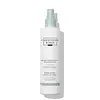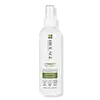What's inside
What's inside
 Key Ingredients
Key Ingredients

No key ingredients
 Benefits
Benefits

 Concerns
Concerns

 Ingredients Side-by-side
Ingredients Side-by-side

Water
Skin ConditioningPropanediol
SolventAloe Barbadensis Leaf Juice
Skin ConditioningGlycerin
HumectantPhenoxyethanol
PreservativePolyglyceryl-4 Caprate
EmulsifyingHydrogenated Starch Hydrolysate
HumectantBehenamidopropyl Dimethylamine
EmulsifyingLinum Usitatissimum Seed Extract
PerfumingLactic Acid
BufferingParfum
MaskingSaccharide Isomerate
HumectantEthylhexylglycerin
Skin ConditioningLimonene
PerfumingLinalool
PerfumingPotassium Sorbate
PreservativeAlpha-Isomethyl Ionone
PerfumingCitral
PerfumingCitric Acid
BufferingSodium Citrate
BufferingSodium Hydroxide
BufferingWater, Propanediol, Aloe Barbadensis Leaf Juice, Glycerin, Phenoxyethanol, Polyglyceryl-4 Caprate, Hydrogenated Starch Hydrolysate, Behenamidopropyl Dimethylamine, Linum Usitatissimum Seed Extract, Lactic Acid, Parfum, Saccharide Isomerate, Ethylhexylglycerin, Limonene, Linalool, Potassium Sorbate, Alpha-Isomethyl Ionone, Citral, Citric Acid, Sodium Citrate, Sodium Hydroxide
Water
Skin ConditioningCetearyl Alcohol
EmollientDimethicone
EmollientBehentrimonium Chloride
PreservativeQuaternium-80
Phenoxyethanol
PreservativePropylene Glycol
HumectantIsopropyl Alcohol
SolventParfum
MaskingSqualane
EmollientButyrospermum Parkii Butter
Skin ConditioningLimonene
PerfumingChlorhexidine Dihydrochloride
AntimicrobialCitric Acid
BufferingHexyl Cinnamal
PerfumingCoumarin
PerfumingBenzyl Alcohol
PerfumingLinalool
PerfumingAmyl Cinnamal
PerfumingGeraniol
PerfumingIsoeugenol
PerfumingAlpha-Isomethyl Ionone
PerfumingHydroxycitronellal
PerfumingBenzyl Benzoate
AntimicrobialCinnamyl Alcohol
PerfumingWater, Cetearyl Alcohol, Dimethicone, Behentrimonium Chloride, Quaternium-80, Phenoxyethanol, Propylene Glycol, Isopropyl Alcohol, Parfum, Squalane, Butyrospermum Parkii Butter, Limonene, Chlorhexidine Dihydrochloride, Citric Acid, Hexyl Cinnamal, Coumarin, Benzyl Alcohol, Linalool, Amyl Cinnamal, Geraniol, Isoeugenol, Alpha-Isomethyl Ionone, Hydroxycitronellal, Benzyl Benzoate, Cinnamyl Alcohol
 Reviews
Reviews

Ingredients Explained
These ingredients are found in both products.
Ingredients higher up in an ingredient list are typically present in a larger amount.
Alpha-Isomethyl Ionone is a fragrance. It can be synthetically created or naturally occurring.
The scent of Alpha-Isomethyl Ionone is described as "flowery" but can also be "woody".
Naturally occurring Alpha-Isomethyl Ionone may be found in Saccharomyces cerevisiae, or the yeast used to make wine and bread.
The term 'fragrance' is not regulated in many countries. In many cases, it is up to the brand to define this term. For instance, many brands choose to label themselves as "fragrance-free" because they are not using synthetic fragrances. However, their products may still contain ingredients such as essential oils that are considered a fragrance.
Learn more about Alpha-Isomethyl IononeCitric Acid is an alpha hydroxy acid (AHA) naturally found in citrus fruits like oranges, lemons, and limes.
Like other AHAs, citric acid can exfoliate skin by breaking down the bonds that hold dead skin cells together. This helps reveal smoother and brighter skin underneath.
However, this exfoliating effect only happens at high concentrations (20%) which can be hard to find in cosmetic products.
Due to this, citric acid is usually included in small amounts as a pH adjuster. This helps keep products slightly more acidic and compatible with skin's natural pH.
In skincare formulas, citric acid can:
While it can provide some skin benefits, research shows lactic acid and glycolic acid are generally more effective and less irritating exfoliants.
Most citric acid used in skincare today is made by fermenting sugars (usually from molasses). This synthetic version is identical to the natural citrus form but easier to stabilize and use in formulations.
Read more about some other popular AHA's here:
Learn more about Citric AcidLimonene is a fragrance that adds scent and taste to a formulation.
It's found in the peel oil of citrus fruits and other plants such as lavender and eucalyptus. The scent of limonene is generally described as "sweet citrus".
Limonene acts as an antioxidant, meaning it helps neutralize free radicals.
When exposed to air, oxidized limonene may sensitize the skin. Because of this, limonene is often avoided by people with sensitive skin.
The term 'fragrance' is not regulated in many countries. In many cases, it is up to the brand to define this term. For instance, many brands choose to label themselves as "fragrance-free" because they are not using synthetic fragrances. However, their products may still contain ingredients such as essential oils that are considered a fragrance.
Learn more about LimoneneLinalool is a fragrance and helps add scent to products. It's derived from common plants such as cinnamon, mint, citrus, and lavender.
Like Limonene, this ingredient oxidizes when exposed to air. Oxidized linalool can cause allergies and skin sensitivity.
This ingredient has a scent that is floral, spicy tropical, and citrus-like.
Learn more about LinaloolParfum is a catch-all term for an ingredient or more that is used to give a scent to products.
Also called "fragrance", this ingredient can be a blend of hundreds of chemicals or plant oils. This means every product with "fragrance" or "parfum" in the ingredients list is a different mixture.
For instance, Habanolide is a proprietary trade name for a specific aroma chemical. When used as a fragrance ingredient in cosmetics, most aroma chemicals fall under the broad labeling category of “FRAGRANCE” or “PARFUM” according to EU and US regulations.
The term 'parfum' or 'fragrance' is not regulated in many countries. In many cases, it is up to the brand to define this term.
For instance, many brands choose to label themselves as "fragrance-free" because they are not using synthetic fragrances. However, their products may still contain ingredients such as essential oils that are considered a fragrance by INCI standards.
One example is Calendula flower extract. Calendula is an essential oil that still imparts a scent or 'fragrance'.
Depending on the blend, the ingredients in the mixture can cause allergies and sensitivities on the skin. Some ingredients that are known EU allergens include linalool and citronellol.
Parfum can also be used to mask or cover an unpleasant scent.
The bottom line is: not all fragrances/parfum/ingredients are created equally. If you are worried about fragrances, we recommend taking a closer look at an ingredient. And of course, we always recommend speaking with a professional.
Learn more about ParfumPhenoxyethanol is a preservative that has germicide, antimicrobial, and aromatic properties. Studies show that phenoxyethanol can prevent microbial growth. By itself, it has a scent that is similar to that of a rose.
It's often used in formulations along with Caprylyl Glycol to preserve the shelf life of products.
Water. It's the most common cosmetic ingredient of all. You'll usually see it at the top of ingredient lists, meaning that it makes up the largest part of the product.
So why is it so popular? Water most often acts as a solvent - this means that it helps dissolve other ingredients into the formulation.
You'll also recognize water as that liquid we all need to stay alive. If you see this, drink a glass of water. Stay hydrated!
Learn more about Water